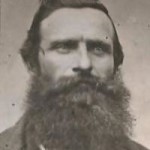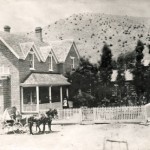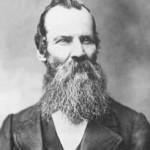George Washington Sevey
1832 – 1902
George W. Sevey, the first Bishop of Colonia Juarez, was born February 25, 1932, in Le Roy, Genesee County, New York. He was a son of George and Hannah Libby Sevey.
In LeRoy, a frontier township, his education was limited to about six months of actual schooling, yet his love of learning made him conversant with topics of the day and gave him what was considered a normal level of education for pioneer times.
He grew into a strong, well built man, with a pleasing personality that drew people to him. He was the main support of his widowed mother, and in 1849, wishing to add to her material welfare, he acquired the “gold fever” that sent hundreds of easterners to California. Hiring himself out as a teamster to accompany of gold seekers, he started his long trek to the West, promising his mother that he would return with enough gold to fill her every need.
On his way west, he heard unfavorable reports of the Mormons and so determined to avoid them. He probably would have bypassed Salt Lake City or made haste to pass through it, had he not become so ill that he was replaced as a teamster and left at a wayside camp. In telling later of this part of the story, he recalled thinking he had died and that his spirit left his body. His spirit hovered near enough to observe the body, repulsive and emaciated as it lay beside a stream. But something told him his work was not yet finished, and that he must re-inhabited his body. He was soon picked up by a passing party and left in Salt Lake City.
Distrustful and fearful of people of whom he had heard unfavorable comments, dreaded contact with them. He had to have work, however, or starve. A friendly Mormon offered him a teaming job, moving freight to Palmyra, Utah. There he took lodging with the Mormon family and was taught the Gospel by the way this family lived. His fears began to seem foolish, and his heart softened. One night he attended a cottage meeting out of curiosity. There a miracle happened. And man to whom he had been listening indifferently, unexpectedly began speaking a strange language. Even more strange was fact that George can understand them. The man was speaking directly to him, in a language non one else could understand. “You must not deny the voice speaking to you, or be deaf to what it is trying to tell you. Listen, and you will be the means of taking the Gospel plan of salvation to your widowed mother and be a savior to her.”
These words so disturbed him that he was unaware of the sermons end. The hush and quiet of the room aroused him and he heard the next speaker ask if anyone had the interpretation of the sermon spoken “in tongues.” When no one responded he wondered why they all could not understand it as well as he had. But his lips are sealed and he could not tell them the wonderful thing that has happened to him. All he could do was sit with questions racing through his mind. When the questioners singled him out and pointed asked, “don’t you know the interpretation?” He merely shook his head. When the meeting was over without any interpretation being given, he walked out, wondering why he had denied something he knew was true. Throughout the night he was tormented by a feeling of cowardice. On his knees, he confessed to his maker his weaknesses, asked for strength to do as his heart dictated, and then dropped into slumber. Then, first the family, and later to the Elders, he confessed to the conviction he had formulated during the night. With peace in his soul, he knew his search for truth was over, that though he had not found the gold he had left home to seek, he found something far more precious. He later fulfilled the promise that he would be a savior to his mother by sending a team to the Mississippi River to meet her, and she was brought to spend her last days in his home in Panguitch. She died a firm believer in the Gospel.
He was baptized May 3, 1853 by Steven Markham, presiding Elder of Spanish Fork, then a frontier town made up of Saints who had to abandon settlement attempts at Palmyra. Here he met the Redds, the Paces and the Butlers to whom he became attached and with whom he was to spend much of his later life. Here he met Lem Redd, who became a lifelong friend, and this friendship was cemented into a family relationship when they married sisters. George married Phoebe Butler, daughter of John Lowe and Caroline Farozine Skeen Butler, December 5, 1854. They spent their early married life in Spanish Fork.
George was helpful in harnessing mountain waters, and bringing life to the sage-covered desert areas and planting orchards, fields and gardens. He was a factor in carrying out Brigham Young’s policy of feeding rather than fighting the Indians and took the lead in a campaign to share food and make friends with them. He built a cabin for himself and his wife on the banks of the Spanish Fork River. She cooked what they ate over an open fireplace. She carded and spun cloth for clothing and he made their shoes. Undaunted they endured pioneer life together.
In 1861, he was called to help settle southern Utah, at Harmony, Washington County, being among the first to locate there. It was then called Ash Fort, and was near old Fort Harmony. They made the trip from Spanish Fork in a covered wagon drawn by oxen, with one extra ox and two cows. They spent the night with John D. Lee had built the fort. George and Phoebe were among the first settlers, and made camp near the Jim Payson family, also relatives by marriage. Their tent was soon replaced with a log cabin.
But the “Big Storm” the next year crumbled the fort, washed away a part of their farmland, and even took two lives. So a move four miles north was imperative, and the town became New Harmony. New settlers arrived, the Redds and more Paces.
George was made First Counselor to Wilson D. Pace when a Ward was organized. He built a three-room log house, cleared land, got a few sheep and cows, peddled what he raised in the mining town of Pioche, Nevada, and soon set up a store in New Harmony with a Mr. Pateson, a Pioche merchant, to back him in the buying and selling of merchandise. It was New Harmony’s first store. He also built a water-powered sawmill with an up-and-down saw, and hauled timber from Pine Valley Mountain with ox teams.
Here he met Margaret Nebraska Imlay, daughter of James Haven and Hannah Eliza Coward Imlay. With her, George made his first step into the principle of plural marriage. Two years later, he was called by President Brigham Young to lead a party and resettle Panguitch now that Indian troubles had subsided. He placed the following advertisement in the Deseret News: “All that wish to go with us to resettle Panguitch Valley will meet at Red Creek on the fourth day of March 1871, and we will go over the mountain in company to settle that country.” From Red Creek (Paragonah) he drove over rough mountainous roads into a high valley where cold and snow had made the fertile valley prohibitive for settlement until arduous labor and wise planning made it into a thriving community. A mountain stream was harnessed, soon making it a community surrounded by ranches and farms, where sheep and cattle businesses prospered. Panguitch, within two years, numbered 500 people, and George became its first Bishop, a position he held for nine years. In 1875 he went with others to Potato Valley to assist in the settlement of what later became Escalante. In 1877, when the Panguitch Stake was organized he was chosen to be the First Counselor to Stake President James Henrei, but still maintained his office as Bishop. In these two capacities he attended the dedication of the St. George Temple in 1877, going by way of Pipe Springs to inspect the source for food that was provided to temple workers.
On December 19, 1877, George married Martha Ann Thomas of Pine Valley, Utah, a daughter of John Pledger and Mahala Matthews Thomas. The following year, as a favor to the Hole-in-the-Rock Expedition, George, in company with Lem Redd, George Morrell and George Hobbs, floated a raft over the Colorado River, and, in deep snow, spent almost a month marking out a wagon road from the Colorado River to Bluff on the San Juan River.
While he was Bishop, many industries were started: shoe and harness shops, a printing press, a shingle mill, pottery plant, and others. The community boasted of many tradesmen, such as carpenters, masons, blacksmiths, seamstresses and musicians. A church-schoolhouse of brick was soon built to climax other enterprises. He was rated as one of the outstanding characters of the pioneer days. He made brooms for sale, shoes for himself and others, and before his life was over he had become successful in farming, stock raising, freighting, and promoted the building of roads, canals, and railroad grades. By 1885 he was considered a well-to-do man. Cattle and sheep stocked his ranches, his barns were filled with hay. His dairy furnished milk which was sold to miners in Nevada. His comfortable homes housed contented families.
But in that year, 1885, the hopeful outlook for the future was drastically changed by the enforcement of the Edmunds Act that outlawed his form of family living. To escape arrest and imprisonment he left it all, took his plural families and joined others fleeing to Mexico. He located at Camp Turley near San Jose on the Casas Grandes River while waiting for land purchases to be completed. There he heard the letter read that appointed him Presiding Elder of Colonia Juarez. When word came to move onto property finally purchased, he led the camp members to what later was called Old Town. When it was discovered that they had put their improvements on private property, he led them to the present site of Colonia Juarez, maintained the same policy toward land ownership and used the same method to build a brotherhood and neighborly atmosphere.
George took a town lot after the survey was completed, and a farm up the river, then started operations for building canals to bring water to the desolate spot their real claim turned out to be. He promoted road building over the eastern hills to facilitate entrance to the town. He scouted the forbidding San Diego Canyon over which lumber had to be hauled from the sawmill on top of the mountains. He encouraged the completion of the school and church house and bought a tannery in which John. J. Walser and sons soon began making leather from the tanned hides of cattle. He established Martha Ann in the lumber home he soon built on his town lot, and Margaret in the same type of home four miles up the river. From an orchard he was soon peddling fruit, and he raised alfalfa on both pieces of property.
In June of 1887, the Juarez Ward was organized and Miles P. Romney and Ernest L. Taylor were appointed as his Counselors, making an outstanding Bishopric. Miles P. Romney kept watch over the morals of the community and promoted cultural activities and set a level that is still maintained. Ernest L. Taylor, besides being the peace officer, promoted businesses of cattle and stock raising. Bishop Sevey, warmhearted and congenial, full of compassion for the erring, quick to see the needs of those struggling against odds, kept the principles of brotherhood growing.
George was saddened when word reached him of the death of his wife Phoebe, who passed away on August 4, 1892 in Panguitch. It was impossible to attend her funeral. This bereavement was beset with another worry, that of Maggie’s ill health. Before the next three years had passed, it was plain to see her illness was malignant. With no medical help in the country to fight this dread killer, and knowing of his good friend Doctor Blackburn in Utah, George immediately fixed a conveyance in which he could travel comfortably and set out to get help. He traveled against time and did his best to cover the miles with all possible speed. It was in vain. Maggie died within a few miles of their destination. He buried her in Panguitch beside his departed Phoebe.
The return to Mexico to move Martha Ann to the farm, put the motherless children into her care, and was soon at work again in his capacity as a ward leader. He made sure that the owner of every lot had his quota of hillside pasture for milk cows. He created a fund for the keeping of widows and those in need. He had the rare art of giving without hurting, and too many he became an Angel of mercy. He frowned on bickering among neighbors and from the pulpit urged his congregation not to “go into the new year with hard feelings against her neighbor. Go to him and acknowledge her faults if you have been wronged. If you can’t fix it up among yourselves, then let the Ward Teachers help.” Created a scab pasture for tithing cattle and a storehouse for produce gathered by the Deacons as fast offerings, and dispensed it to those in need.
George’s long life on the frontier was taking its toll, however. In deference to this he was released as Bishop in 1896, is six years later he died, on June 22, 1902. He was buried in the cemetery in Colonia Juarez. He left the posterity of 30 children, among whom are financiers, state legislator, bishops, many missionaries and church workers, all blessed with benign qualities and all promoters of the love of brotherhood.
Tom Sevey, son
Stalwart’s South of the Border Nelle Spilsbury Hatch page 605



